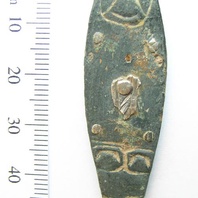
Viking Objects
Zoomorphic Strap-End (SWYOR-B89D43)
This Thomas Type A strap-end is decorated with zoomorphic designs and what seems to be a face which may fall into the Trewhiddle style. There is some trace evidence of silver plating. Strap-ends came in various styles and were fairly common throughout the Viking world. They were used to decorate the ends of belts and to stop them getting damaged.
Read More
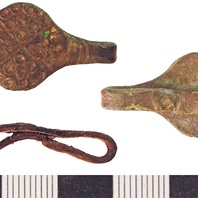
Viking Objects
Imitation Finger Ring (NLM-D675CA)
This finger ring bears stamped decoration imitating the Scandinavian ring and dot pattern which is bordered by incised crossing diagonals of a saltire. The ring- and dot-style of decoration was briefly adopted by inhabitants of Anglo-Saxon settlements such as Cottam in Yorkshire and Flixborough in Lincolnshire.
Read More
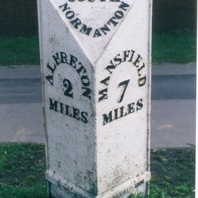
Viking Names
South Normanton
South Normanton, in the Scarsdale Hundred of Derbyshire, takes its name from the Old English ethnonym Norðman ‘Northman, Norwegian’ and the Old English element tun ‘farm, settlement’. There are several places of this name, predominantly in the East Midlands: five in Nottinghamshire, also others in Derbyshire, Leicestershire, Lincolnshire and Rutland, and one in the West Riding of Yorkshire. The prefix South distinguishes it from Temple Normanton, formally North Normanton. Traditionally, the place-name has been interpreted as referring to a settlement of Norwegians (in an area where most of the Scandinavian settlers were Danes). However, the exact implications of such a name are not yet fully understood and are the subject of ongoing work by Dr Jayne Carroll of the Institute for Name-Studies, University of Nottingham.
Read More
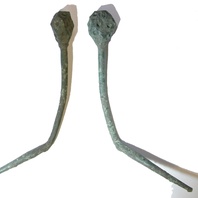
Viking Objects
Ring-and-Dot Pin (1986/976-SF4)
This copper alloy pin with a ring-and-dot pattern on the head was used for fastening cloaks. It was found on the site of Little Chester Roman fort. Pins like this were common in Ireland and the western British Isles, and spread further afield under Viking influence.
Read More
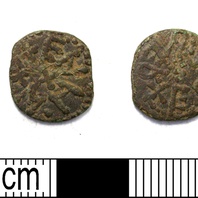
Viking Objects
Northumbrian Styca (LEIC-0D9D6F)
This Northumbrian styca was probably minted in the name of Æthelred II of Northumbria possibly by the moneyer Eanwulf. While Wessex and Mercia were using silver coinage as part of their monetary economy, Northumbria was using copper coins known as stycas, which may have contained trace amounts of silver. The concentration of these coins at sites such as Torksey and ARSNY (‘a riverine site near York’) suggests that they could have remained in circulation after the fall of Northumbria in 866 but were taken to these sites by the Vikings during their campaigning. This particular example was likely brought to Nottinghamshire from Northumbria by means of the Great Army’s overwintering activities in and around Nottingham.
Read More
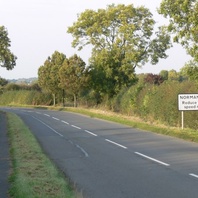
Viking Names
Normanton
Normanton, in the Framland Hundred of Leicestershire, takes its name from the Old English ethnonym Norðman ‘Northman, Norwegian’ and the Old English element tun ‘farm, settlement’. There are several places of this name, predominantly in the East Midlands: five in Nottinghamshire, and some in Derbyshire, Leicestershire, Lincolnshire and Rutland, and one in the West Riding of Yorkshire. The settlement lies in the Vale of Belvoir and previously had the affix in le Vale. Traditionally, the place-name has been interpreted as referring to a settlement of Norwegians (in an area where most of the Scandinavian settlers were Danes). However, the exact implications of such a name are not yet fully understood and are the subject of ongoing work by Dr Jayne Carroll of the Institute for Name-Studies, University of Nottingham.
Read More
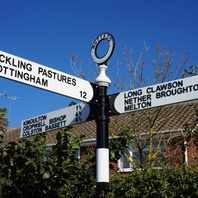
Viking Names
Hickling
Hickling, in the Bingham Wapentake of Nottinghamshire, has a name that was given probably quite early in Anglo-Saxon times in Old English. It is also recorded relatively early, first in a 14th-century copy of a document originally written around 1000. The -ing suffix indicates that the name refers to a group of people, who belonged to or were named after a person called Hicel(a). It is therefore not a Viking name. However, it is included here because St Luke’s Church in Hickling is the location of an early medieval grave-cover that is often regarded as a ‘hogback’ a type of Anglo-Scandinavian monument generally found further north (indeed this would be the most southerly example). It is quite common for sculpture with Scandinavian features or showing Scandinavian influence to be found in villages with English names, and this applies to other forms of material culture too. There is therefore no automatic connection between the name of a place and other evidence for Scandinavian influence, and this raises many interesting questions about the processes of acculturation, integration and diaspora that resulted from the Viking invasions.
Read More
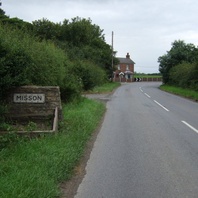
Viking Names
Misson
Misson, in the Bassetlaw Wapentake of Nottinghamshire, is a difficult name. It may be a river name, of which the first element has affinities with Danish mysse, Swedish myssene, or Old Norse mysni ‘a water-plant (?water-arum)’ either as a simplex name or combined with Old Norse á ‘a river’. Alternatively, the name might derive from Old English mos ‘a bog, a swamp; presumably also moss’.
Read More
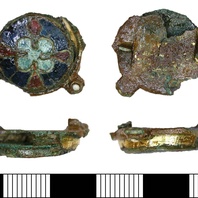
Viking Objects
Enamel Copper-Alloy Brooch (DENO-6C0D22)
This composite cast copper-alloy and enamel gilded brooch displays both Anglo-Scandinavian and Anglo-Saxon characteristics. The decorative enamel centre of the brooch was fabricated using a method known as cloisonné which involves the use of inlaid enamel cells, separated by strips of copper alloy, within an outer ring of copper alloy, all set upon a flat circular disc of copper alloy. The sides of the decorative roundel are surrounded with an upright strip of gilded copper alloy. The design of the enamel centre features a blue-green central quatrefoil, four cells which are shaped like elongated teardrops filled with red enamel giving the appearance of a cross motif, and four larger sub-rectangular cells filled with deep blue enamel. The brooch has been classified as Weetch Type 20. For more information on Scandinavian jewellery in England check out our blog: Brooches, Pendants and Pins: Scandinavian Dress Accessories in England.
Read More
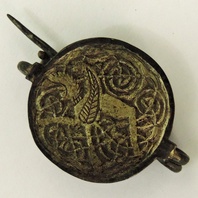
Viking Objects
Silver Gilt Brooch (1989-58/7224)
A circular silver gilt plate brooch with chip carved decoration of a winged creature. The creature may be a griffin. It is enmeshed in fine spiralling interlace. The reverse features a U-shaped catchplate and pin with a spring. This decoration is Mercian in style. For more information on Scandinavian jewellery in England check out our blog: Brooches, Pendants and Pins: Scandinavian Dress Accessories in England.
